By Irma Allen*
A rewilding movement that bases itself on arguments around overpopulation, without interrogating the power structures that are enabling it, is in danger of failing to generate the kinds of solidarities, social justice outcomes and progressive visions of wildness that we so desperately need.

Source: Wikimedia Commons
Rewilding is big news in environmental conservation. At the Future of Wild Europe conference at the University of Leeds in September, where top conservation practitioners and academics met to share perspectives on all things wild, it was undoubtedly the key story. Rewilding has hit UK newspaper headlines and filtered through into global NGO strategies, spawning its own generation of institutional backing via new initiatives and organisations. Great news, you might think – and one would hope so.
But, just as environmental historian William Cronon in his now (in)famous essay The Trouble With Wilderness was perturbed by unexamined ideals of wild nature as untouched and inhuman within the environmental movement in the 1990s, I was troubled by things I was hearing at the conference in Leeds over twenty years later. In particular, I was troubled by echoes of a lingering and pernicious legacy of colonial, neo-Malthusianism that, for me, tainted the celebratory, go-getting tone.
It made me anxiously wonder – are we at risk of once again practicing conservation by dispossession, to borrow David Harvey’s well-known phrase? Have we dealt with the uncomfortable past of imperial ecology sufficiently to confidently move towards a more progressive vision of the wild as Cronon implored us to do? I worry the answer is yes to the first question, no to the second.
Before I carry on, I wish to raise the flag of unease with which I proceed and state upfront that I am a passionate supporter of wildlife conservation. The concept of rewilding intuitively appeals to me deeply. But I share William Cronon’s personal tension between “celebrat[ing] the protection of wild nature” and acting on this on the one hand (Cronon was himself a conservationist) and attending to the “task of self-criticism” and “deep reflection” on the other.
It is a tension I think we must uphold. Yet, like those who received William Cronon’s seemingly devastating critique with a sense of genuine anxiety as to which hands such an open questioning of the wilderness ideal and of environmentalism itself might fall into, I, too, proceed with trepidation. So here I attempt an affirmative critique – one that seeks to support not derail, but perhaps in other directions.

Pleistocene rewilding? Source: Pinterest
To return to the trouble (and staying with it): there are three main interlinked issues that I wish to raise about rewilding. The first deals with the problem of racialized neo-Malthusian preoccupations with carrying capacity that seem to have ongoing traction. When Toby Aykroyd, businessman and Founder of Rewilding Europe, spoke at the Leeds conference careers session to us budding ‘Early Career Scholars’, he described his post-business school personal journey into nature conservation as starting with getting involved in family planning in East Africa.
I have to say I was already quite surprised at this easy connecting of, in my mind, very historically uncomfortable terrains. I wanted to know more, to check my small alarm bell that started to ring. I discovered that Aykroyd is the co-founder of the Population and Sustainability Network in 2003, which exists to “increase the prominence of population dynamics in international development policy” promoting reproductive health and family planning services in the interests of a broader sustainable development agenda.
Provision of free family planning is a fantastic achievement in and of itself, yet when motivated by concern over natural resources and carrying capacities, and linked to power-laden development agendas, this shades into murkier territories and rationales that I find deeply uncomfortable.
Back at the conference, a panelist from Spain involved in a senior role in a Spanish conservation organization reportedly proposed (in no joking manner, were it possible to joke about such things) that one of two possible solutions to the “population problem” was either to “sterilize women” – or to educate them. I was not present at the time, but apparently he was neither challenged nor confronted on this by the audience.
Perhaps the silence was just out of unease or lack of attention. But the absence of further discussion on these threads, and a lack of desire to pull on them to see what unravels, I believe reveals a possible precarity on which some alliances are being built.
For the troubling link between nature conservation and colonial attempts to control populations has been well researched. Such ideologies have led to violent dispossession, racialized forms of controlled access and, yes, even forced sterilization. I am not saying that an involvement in family planning is similar to or the same as this in any way – but I am pointing to unnerving and deeply toxic trajectories of where such thinking can point or to what other kinds of thinking it can join up with.
Digging deeper into the genealogy of rewilding we confront further problematic ties. According to rewilding academics Jamie Lorimer et al and Dolly Jorgenson, the term was first coined in the US through a collaboration between the deep ecologist Dave Foreman and conservation biologist Michel Soule in the 1980s in the formation of the Wildlands Project.
Dave Foreman is the Founder of the controversial activist group Earth First!, author of Man Swarm: How Overpopulation is Killing the Wild World, and is current president of the US Rewilding Institute. However, Foreman has been quoted on his own organization’s website as saying
“The Aids epidemic, rather than being a scourge, is a welcome development in the inevitable reduction of human population… If [it] didn’t exist, radical environmentalists would have to invent [it].”
During the Ethiopian famine, eco-anarchist Murray Bookchin also quoted him as saying:
“The worst thing we could do in Ethiopia is to give aid [to the starving children] — the best thing would be to just let nature seek its own balance, to let people there just starve.”
That was a long time ago, but can rewilding make a leopard change its spots?
Judging by echoes of this sort of logic creeping around and seeping through the sides of sincere and progressive discussion back at the academic-practitioner conference in Leeds, not so fast. As the Weeden Foundation (a previous grant-donor for The Rewilding Institute – TRI) writes on its website: “Dave Foreman… is an outspoken advocate of stabilizing population, and TRI works to integrate population and immigration issues into its environmental analysis and message.”
I am not sure I need to spell out the implications of such a stance in the US context at a time when Donald Trump has just become the next President.

Why is this sort of highly problematic thinking not being discussed and dissected in rewilding circles? A rewilding movement that basis itself on the overpopulation factor is in danger of failing to generate the kinds of solidarities, social justice outcomes, and progressive visions of wildness that we so desperately need. Fletcher, Breitling and Puleo highlight the problem:
“By conjuring the age-old image of animalistic barbarian hordes breeding inexorably and therefore overflowing their Third World confines to threaten the security – and enjoyment – of wealthier nations, the overpopulation bogeyman helps to displace attention from systemic issues within the political economy of development, namely, the futility of pursuing sustainable development within the context of a neoliberal capitalism that characteristically exacerbates both economic inequality and environmental degradation.”
Many overpopulation supporters argue that they do acknowledge the twin role of overconsumption – as does the Population and Environment Network. However, overconsumption usually is, attributed distant second place in policy focus, if at all. “In the process, inequality itself is actually defended in the interest of sustainability”, political ecologist Robert Fletcher writes.
This brings me onto my second concern. While on the one hand overpopulation theories were subtly present in the impetus behind at least some key people’s involvement in rewilding, at the same time we learnt at the conference that one of the main reasons why it has been able to gain so much traction within the European context is due to ‘depopulation’, particularly in rural areas, largely as a result of de-agrarianisation.
Europe is indeed experiencing a dramatic decline in population, most notably in the countryside. Why? One major reason is that we have exported much of our production, agricultural and otherwise, overseas, thus freeing up large tracts of land.
A comprehensive report published by Humbolt University of Berlin found that over the past 20 years, the EU has evolved into the single largest importer of agricultural commodities and food worldwide. In 2007/2008, for example, almost 35 million hectares of land beyond European borders, almost equivalent to the territory of Germany, was used for the benefit of Europeans. This makes the EU a net food importer of so-called “virtual agricultural land”, placing it at risk, the report says, of accusations of land grabbing, and contributing to “negative economic externalities in the form of reductions in natural habitats such as tropical rain forests and increasing greenhouse gas emissions from converting forests and grasslands into cropland”.
How can we build a rewilding movement that simultaneously resists and challenges these negative socio-ecological impacts? For it is here, I would argue, that the crisis lies most explicitly. I was disappointed to note that an engagement with the causes behind this freeing up of land does not seem to be present in rewilding literature. There seems, instead, to be a quiet celebration of this process. Dolly Jorgenson refers to the opportunities “declining agricultural production” opens for rewilding, yet does not investigate further. The journalist George Monbiot says:
“In Europe, between 2000 and 2030 we’ll see 30 million hectares of land being vacated by farmers, which is an area the size of Poland. It’s in places like these… where arable farming is much less viable, that I think we have enormous potential for rewilding”.
I am glad Monbiot mentions Poland. For one of the main drivers behind ‘depopulation’ in rural areas here is loss of livelihoods in the face of EU-backed capitalist industrialization of the countryside. Today, Poland is facing rising organized protest from farmers unable to compete on the market, facing imposed EU standards that favour large-scale agriculture, and unable to sell domestic produce even locally due to restrictive health and safety proscriptions. Mobilizations and sit ins have been the result. In February 2015, for example, 150 tractors blockaded the main motorway leading into Warsaw – the country’s largest farmer uprising.
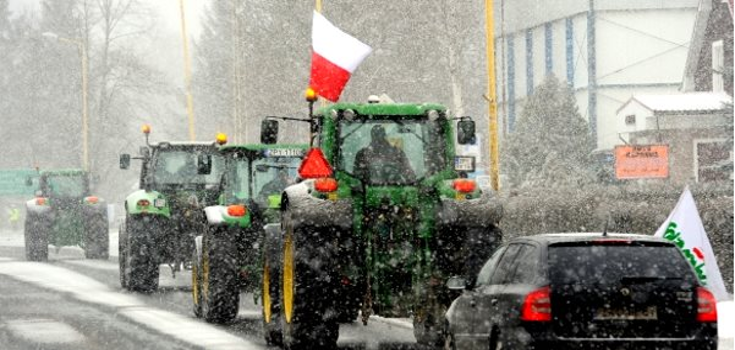
Poland’s largest farmer uprising, February 2015. Source: Natural Society
One of their main concerns also relates to land grabbing. As a 2015 European Parliament report found, land grabbing is a “creeping phenomenon” that is not alien to the European mainland – indeed, it is occurring increasingly, often via a new asset class of banking, pension and insurance funds, and concentrated particularly within Eastern European states. The report finds:
“Against the backdrop of dramatic levels of land concentration and the rapid exit of Europe’s small farms, farmland grabbing, through its control, privatization and/or dispossession of natural resources, has become an active factor in the further weakening of the socio-economic and environmental vitality of the rural sector. It is leading to the further erosion of Europe’s model of family farming based on a sustainable and multifunctional form of agriculture and blocking the entry into agriculture of young and aspiring farmers.”
The key point here is that there is nothing neutral about processes of rural depopulation. Rather than passively celebrate their demise, should rewilding advocates not align themselves with small-scale farmers, whose practices, at least in Europe, can often encourage far greater biodiversity, and are themselves perhaps part of the very notion of ‘wild’ we might want to cultivate – non-homogenous, diverse, non-standardised, and self-willed?
We should also pause and reflect deeply on the paradox that, while we celebrate depopulation in enabling rewilding, we do so while seemingly claiming neo-Malthusian viewpoints on over-crowding and at a time when thousands of people have risked their lives to journey to Europe in search of refuge but are literally being fenced out and forced back with rhetoric of ‘swamping’, ‘inundation’ and ‘flooding’.
Are Malthusian arguments for ‘space for nature’ feeding into a lack of a European response to refugees? How does rewilding relate to growing European nationalist discourses? We must be at least asking such questions. What does it mean to talk about rewilding without interrogating the violent structures that are perhaps involved in making it possible? I fear a loss of the very enchantment and progressive hope that rewilding seeks to preserve.
This leads me to my third and final point.
Given the context I have just discussed, it is striking that Central and Eastern Europe seems to be becoming somewhat of a home for rewilding. Rewilding expert Jamie Lorimer himself commented on this back at the Leeds conference in his keynote presentation.
For example, Rewilding Europe, mentioned earlier, has become the leading European platform for rewilding and is trialing its activities so far in nine European areas across ten countries. Eight of these areas are listed on the website at present and shown in the map below. Six out of eight of these are located within Europe’s top twenty poorest countries (Bulgaria, Romania, Poland, Croatia, and Portugal). One is located in northern Sweden in Lapland, home of the indigenous Sami peoples. The last is located in Italy.
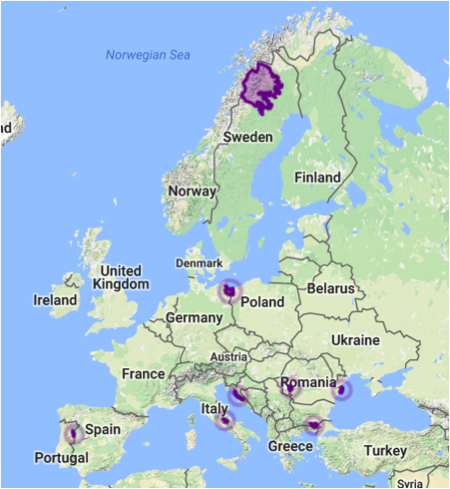
Source: rewilding.com
Why are the historically marginalized regions of Central and Eastern Europe seemingly becoming centre stage for rewilding? This seems an important question to at least ask. Is it linked to de-agrarianization? Should we not interrogate the unequal power dynamics at play between West and East in this set up?
Funding for this initiative is coming from largely Western European-based organizations, including 3 million Euro startup money from the Dutch Postcode Lottery, support from WWF-Netherlands, and backing from London-based ‘conservation enterprise’ investment company, Conservation Capital. This latter organization has “raised and structured over 200 million Euros of private investment finance for conservation-based businesses across 26 countries” and interested in developing a “nature-based economy in key areas of rural Europe where declining forms of economic activity (primarily agriculture) will be replaced with new wildlife and wilderness-based businesses”.
What sorts of relationships of bio-capitalism are we witnessing here? Or should we more see this as a redistribution of resources in a positive light? Where is the debate on this?
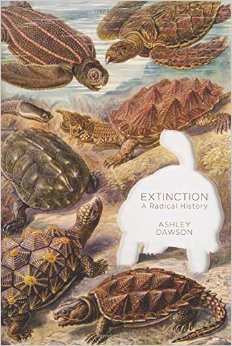
In his recent book Extinction: A Radical History, Ashley Dawson explicitly ties the issue of extinction to capitalist modes of production, exploitation and histories of dispossession. As such he calls for an “anti-capitalist movement against extinction [that] must be framed in terms of a refusal to turn land, people, flora, and fauna into commodities” particularly when cloaked “in arguments about preserving biodiversity”.
I must agree, and yet Dawson seems to limit his critique too narrowly to relations between ‘Global North and South’. He bemoans the fact that “all too often rewilding schemes focus exclusively on wealthy areas of the planet”, such as Europe. While I support Dawson’s radical focus on distributive justice, I would caution that rewilding could come in capitalist guise itself.
Moreover, an indiscriminate lens on the ‘Global North’ does little to reveal the inequities and power relations occurring within Europe’s own borders, not to mention placing a generalized blame for colonialism on countries that have never been colonial powers, and indeed, recently, have themselves been explored through a post-colonial lens.
Once again, Eastern Europe gets invisibilized and erased from notions of ‘Europe’ and the ‘Global North’ more generally. Of course European countries are much wealthier than the world’s poorest, but that still does not alter the huge discrepancies between European countries in which many were only counted as ‘European’ very recently, and even then, precariously so.
To conclude – rewilding is not a return but a future-in-the-making. It is a wholly natural-cultural project in becoming-with. Imaginations of rewilded places must therefore be steeped in the recognition of what political ecologist Bruce Braun calls the “irreducible nature of experimentation at the heart of rewilding practices”. Where we make them, how come, with and without whom, all matter to the kinds of experiments we are carrying out. History itself is forgotten in this process at our peril.
*Irma Allen is a Marie Curie PhD Fellow at the Environmental Humanities Laboratory, KTH Royal Institute of Technology in Stockholm, Sweden, and is part of the ENHANCE ITN.



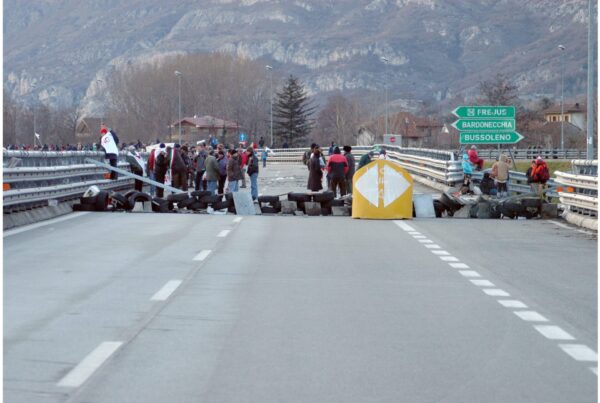
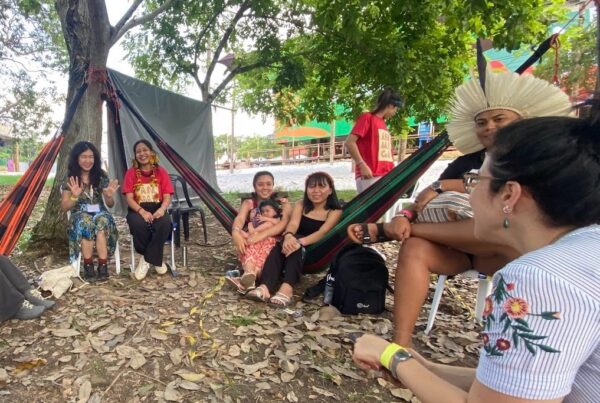

Great post. History and politics has been much ignored in wildlife conservation. Also the nature-society dualism is behind of these processes. Thanks!
Thanks Irma.
I read Hardin’s ‘Tragedy of the Commons’ last year and was troubled by its deeply misanthropic tone: this is alive and well in some quarters.
The global per capita ‘ecological footprint’ is rising faster than it population, and it’s (mostly) the countries most ‘guilty’ of over-reproducing that are the ones whose populations live within their planetary footprint capacity and those with stable or declining populations that live way above theirs – http://www.footprintnetwork.org/ecological_footprint_nations/ecological_per_capita.html.
It was good that there were a variety of ‘voices’ at the conference, many of whom spoke from a different perspective from the one that troubled us.
Reblogged this on ecoartscotland and commented:
If you are interested in ‘rewilding’ then it is worth reading this, oruginally posted on ENTITLE
These are the kinds of conversations that need to happen before any sort of conservation or ‘rewilding’ can take place. Enjoyable article.
An interesting essay Irma, though rather too many big words and phrases for a simple Yorkshireman to easily understand. A few comments though if I may…
1) I think you’re at risk of reading too much in to the whole imperialistic and Neo-Malthusian spectre that stalks any discussion of wild and rewilding. It makes for fascinating reading but I just think it is an intellectual side-show. Please don’t disrespect Toby Aykroyd. He’s done more to get wilderness protection on the European agenda than any one I know and deserves a medal. You should look up to him and support what he’s doing instead of questioning his motives
2) The real issues are about giving nature space to be wild, instead of just take, take, take all the time. In doing so we could support the wider health of the planet and the web of life through natural processes and associated ecosystem services that wilderness and those less-human modified landscapes provide in spades. Toby recognises this and so should you.
3) At the risk of sounding like one of your misanthropic Neo-Malthusian types, the elephant in the room whenever we think about sustainability (in all it’s guises) is population growth. Unless it passed you by we exceeded the 7 billion people mark in 2011 and are now at 7.5 billion with UN projections suggesting we’ll top 11 billion by 2100. If you want any semblance of wild nature in the future, then we must address this issue, head-on. If we don’t, then we’ll only see more degradation, more extinctions, more wars, more famine and more poverty and more civil unrest. This is no time for navel-gazing.
4) There will always be inequalities, east-west, north-south, uptown-downtown, urban and rural, it doesn’t matter, but Geography does. Scale and relativity together with environmental drivers (climate, geomorphology, geology, latitude, altitude) will always determine the pattern of exploitable resources (farmland, forests, energy, water) and hence the patterns of economic wealth. Rather, it is the political and economic systems that are at fault in terms of the distribution of those resources among the world’s population. Money and land begets power and influence and with that comes responsibility. That’s where you need to address your intellectual energies in my honest opinion.
5) I’m no fan of Rewilding Europe. For one, they are too focused on the economic aspects of wildlife in “viewable numbers” that they maintain will generate tourism revenue. The problem is that viewable numbers means unnatural numbers and this is not the kind of “rewilding” I want to see. They are also wedded to the Dutch/Vera view of nature in open and semi-open landscapes which is questionable to say the least. But don’t be lured by their well-oiled and glitzy PR machine into thinking they represent rewilding in Europe. They are just one, slightly saccharine flavour, and not all rewilding is focused on poorer regions or Eastern Europe. Germany for example, has a target of creating and designating 2% of its land areas as Wilderness by 2020. And there are several high profile rewilding projects in the British Isles.
6) Finally I’d just like to remind you that it was Europeans (largely) that exported the idea of wild(er)ness to the rest of the world and in doing so has helped to create a network of wildlife parks and refuges (see ProtectedPlanet.net) that has saved many species and habitats from certain extinction. As far as I can see, there seems to be little danger of Homo sapiens sapiens ending up on the IUCN Red List. The good thing is that after centuries of exporting the idea of wilderness, we are now beginning to re-import it back to our own continent. This has got to be seen as a good thing, and if we can bolster that with carefully selected rewilding projects that link these protected areas up into a connected and future-proofed network then that’s great.
If you want to read some more home-truths I’ll direct you towards me recent articles in ECOS wherein I chew over the rewilding movement in more detail.
http://www.wildlandresearch.org/media/uploads/Making-real-space-for-nature-REVISED-VERSION-3.pdf
http://www.wildlandresearch.org/media/uploads/Flood-management-and-nature-ECOS-37-1.pdf
http://www.wildlandresearch.org/media/uploads/ECOS-372-Carver.pdf
Thank you for this interesting and thought-provoking piece.
Conservation raises a number of critical issues, and many contradictions. In the face of declining “natural” areas and biodiversity the temptation is strong to justify the means conservation projects employ by the end, that is: the important goal of protecting global commons and endangered species and habitats, without reflecting on their social implications particularly at local level.
In a recent paper, we argue that conservation, with all the positive aspects it may have, fundamentally seeks to compensate for, rather than question the destruction of nature related to over-exploitation of natural resources. One could say that is because the destruction of nature is taken for granted, that so much effort is put on creating conservation areas, where “nature” and “wilderness” may be preserved or (re)created by displacing local populations and / restricting their rights to use natural resources.
The expansion of conservation areas worldwide is a recognised goal in international policy, as best illustrated in the Aichi Goals (especially Target 11 – Convention of biological diversity). Conservation areas do expand, but not uniformly. For Watson et al. (2014: 69) their distribution still shows an important bias “towards higher elevations, steeper slopes, and lands of lower productivity, lower economic worth and low human density”. Basically, they are often designated in remote areas, where settlement or land use have not been so easy. These areas are, nevertheless, far from being empty of humans. Local populations have historically often played a key role in co-creating landscapes and biodiversity, though they are often seen as the main agents of destruction in, and around, protected areas and often lack the political and economic power to defend their rights and access to land and resources.
This is where the issue of justice becomes important, because it stresses the existing tensions between conservation endeavours and their impact on the dignity and human rights of local populations. As long as the over-exploitation of natural resources and environmental degradation continues (almost) unhindered and obviously driven by the resource demanding lifestyles of industrial countries, it is relevant to ask: who may legitimately decide, which resources can be exploited and which areas should be protected? A key question, we cannot avoid asking is then: for the benefit of whom? Conservationists want to give “nature” a voice and certainly do much to preserve certain kinds of “nature” (especially “charismatic” species and a “nature” that is devoid of humans, except one may say provocatively for [eco]tourists), but shouldn’t this go hand in hand with a profound questioning of the societal processes that have brought us to the point where so little “nature” is left in the first place?
A. Cristina de la Vega-Leinert
(Geography and Geology Institute, Ernst-Moritz-Arndt University Greifswald, Germany)
&
Peter Clausing (México vía Berlin, Germany)
You can find our paper by following the link below:
Anne Cristina de la Vega-Leinert and Peter Clausing (2016) Extractive Conservation: Peasant Agroecological Systems as New Frontiers of Exploitation? Environment & Society, vol. 7: 50–70. DOI: http://dx.doi.org/10.3167
/ares.2016.070104
http://www.berghahnjournals.com/view/journals/environment-and-society/7/1/environment-and-society.7.issue-1.xml
—
Convention on biological Diversity. Aichi Biodiversity targets. https://www.cbd.int/sp/targets/
Watson, James E.M., Nigel Dudley, Daniel B. Segan, and Mark Hockings. 2014. “The Performance and Potential of Protected Areas.” Nature 515: 67–73, doi: 10.1038/nature13947.
Very interesting and stimulating post,. I was also at the Leeds conference, and it is good to see these issues raised here. I have written some of my own thoughts on these topics here:
https://theculturalwilderness.wordpress.com/2016/12/27/rewilding-and-malthus/
I think the points are well-made about Mathussian influence on rewilding- personally I think it will be difficult to shake off since rewilding is a broad church and means many different things to different people, so all the more important to discuss openly.
I am not sure why you used the earlier study on European virtual land imports- more recent data show a clear reversal of the trend, and it is worth looking at the breakdown of different imports. see Noleppa, S., & Cartsburg, M. (2014). “Another look at agricultural trade of the European Union: Virtual land trade and self-sufficiency”.
I think rewilding and HNV farming are somewhat different things- RW tends to be a challenge to the land-sparing approach of current agri-environment schemes and policy, favouring experimental sites to withdraw managment and allow natural processes to come to the fore- by its very nature of a focus on process, this would likely mean the loss of some of those farmed and cultural landscapes.
this suggestion — “that one of two possible solutions to the “population problem” was either to “sterilize women” – or to educate them” is particularly ironic since women are capable, generally, of having no more than one child per year while men are capable of creating many many times more than one child a year. Not that I favor sterilizing anyone, but just pointing the mysogynistic irony.
Thank you for articulating some of my own concerns with regard to rewilding. Also appreciated many of the comments. Obviously a case of no one size fits all, though all efforts to reestablish wild places or to allow them to regenerate where possible, will be of benefit in the fight against climate change and further extinctions.
– best regards,